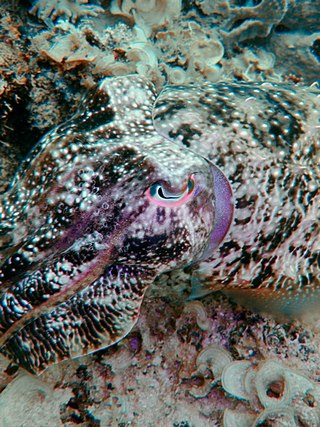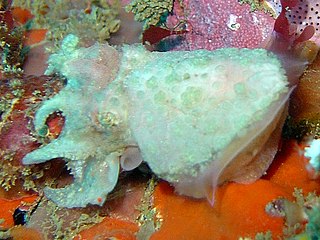
Sepia latimanus, also known as the broadclub cuttlefish, is widely distributed from the Andaman Sea, east to Fiji, and south to northern Australia. It is the most common cuttlefish species on coral reefs, living at a depth of up to 30 m.

The common cuttlefish or European common cuttlefish is one of the largest and best-known cuttlefish species. They are a migratory species that spend the summer and spring inshore for spawning and then move to depths of 100 to 200m during autumn and winter. They grow to 49 cm in mantle length (ML) and 4 kg in weight. Animals from subtropical seas are smaller and rarely exceed 30 cm in ML.
Sepia adami is a species of cuttlefish native to the southwestern Indian Ocean. It is known only from the type locality, S 79ºE off Cape Natal. It lives at a depth of up to 99 m.
Sepia aureomaculata is a species of cuttlefish native to the northwestern Pacific Ocean, specifically the Kii Channel, Tosa Bay, Hyuga-Nada, and the East China Sea. It lives at a depth of between 190 and 350 m.
Sepia erostrata is a species of cuttlefish native to the northwestern Pacific Ocean, specifically off western mainland Japan, from Sagami Bay to the Kii Peninsula. It inhabits subtidal, inshore habitats. It is the commonest species of cuttlefish occurring in rocky shorelines around Japanese coasts.
Sepia hieronis is a species of cuttlefish native to the southeastern Atlantic Ocean and southwestern Indian Ocean, specifically southern Namibia, from approximately 27°S to Port Alfred, South Africa, and east Africa from 17°S to Kenya and Mozambique. It is also present in the Saya-de-Malha Bank. It lives at depths of between 43 and 500 m, although it is most abundant at 110 to 250 m depth.

Sepia mestus, also known as the reaper cuttlefish or red cuttlefish, is a species of cuttlefish native to the southwestern Pacific Ocean, specifically Escape Reef off Queensland to Murrays Beach off Jervis Bay. Reports of this species from China and Vietnam are now known to be misidentifications. S. mestus lives at a depth of between 0 and 22 m.
Sepia mirabilis is a species of cuttlefish native to the western Indian Ocean. Specifically, it is present off Sokotra Island, and its natural range probably stretches to the east coast of Africa. It lives at depths to 50 m.

Sepia novaehollandiae is a species of cuttlefish native to the southern Indo-Pacific. Its natural range stretches from Shellharbour, New South Wales to North West Shelf in Western Australia. It lives at depths of between 15 and 348 m.
Sepia hedleyi, or Hedley's cuttlefish, is a species of cuttlefish in the family Sepiidae, endemic to subtropical and temperate waters off Australia.

Sepia papillata is a species of cuttlefish native to the southeastern Atlantic Ocean and southwestern Indian Ocean. Its natural range stretches from Lüderitz Bay, South Africa, to the coast of KwaZulu-Natal off the Tugela and Umvoti Rivers. It is also present in Mascarene Ridge. It lives at depths of between 26 and 210 m.
Sepia pardex is a species of cuttlefish native to the western Pacific Ocean, specifically off Japan, along the Pacific coast from the Chiba Peninsula, and along the Japan Sea coast from Toyama Bay to South Korea. It is also present off Taiwan and in the East China Sea. The depth range of this species is unknown.
Sepia pulchra is a species of cuttlefish native to the southeastern Atlantic Ocean, specifically off the Cape Peninsula in South Africa. It lives at depths of between 15 and 50 m.
Sepia subtenuipes is a species of cuttlefish native to the western Pacific Ocean, specifically the East China Sea and the Kii Channel in southwestern Japan. It lives at depths of 90 to 300 m.

Sepia tuberculata is a species of cuttlefish native to South African waters from Melkbosstrand to Knysna. It belongs to the genus Sepia. It lives in very shallow water to a depth of 3 m. It is endemic.

Sepia prashadi, common name hooded cuttlefish, is a widely distributed species of cuttlefish. It has a thin, oval body and grows from 5 to 11 cm. The tips of the tentacles have a distinct club shape. S. prashadi is a migratory, demersal cuttlefish living in shallow waters at depths of approximately 40 to 50 metres. It is found in many locations including the east coast of Africa, around India, in the Red Sea, and Persian Gulf.
Sepia braggi, the slender cuttlefish, is a species of cuttlefish native to the Indo-Pacific Ocean. It has been found in coastal waters of southern Australia. This species was first collected in South Australia by its namesake, William Lawrence Bragg. Sepia braggi was then described by Sir Joseph Cooke Verco in 1907.Sepia braggi is part of the subgenus Doratosepion which contains to 41 species of cuttlefish in total.

Sepia elegans, the elegant cuttlefish, is a species of cuttlefish in the family Sepiidae from the eastern Atlantic Ocean and the Mediterranean Sea. It is an important species for fisheries in some parts of the Mediterranean where its population may have suffered from overfishing.
Sepia bertheloti, the African cuttlefish, is a species of cuttlefish from the family Sepiidae which is found in the warmer waters of the eastern Atlantic Ocean off Africa.

Sepia orbignyana, the pink cuttlefish, is a species of small cuttlefish from the family Sepiidae. It is occurs in the temperate and tropical waters of the eastern Atlantic Ocean.









